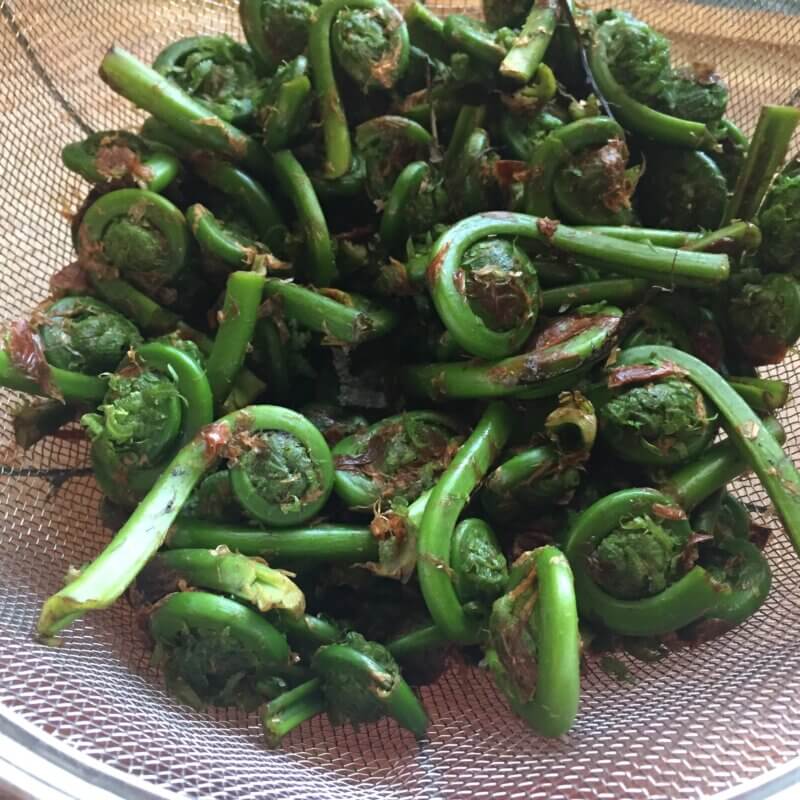Fiddlehead ferns only a spring delight if you cook them right
It’s almost time, you will find them soon — fiddlehead ferns, a local delicacy that signals the arrival of spring.
I was lucky enough to grow up in rural New England with an uncle who lived across the road, an avid forager of all things delectable in the woods. We feasted on mushrooms, ramps and other tasty early spring sprouts, ground nuts, berries of all types and his favorite fiddlehead ferns.
Fiddleheads are the early, tightly coiled sprout of the ostrich fern and resemble asparagus in taste and texture. They are called fiddleheads because they resemble the curled ornamentation on the end of a fiddle or other stringed instrument.
If left on the plant, each fiddlehead would unroll into a new fern frond. They are not cultivated, but are gathered in the wild in the northern United States and in Canada.
These sprouts provided the native population a needed hit of nutrients at this time of year, almost a spring tonic. Fiddleheads are a powerhouse with good antioxidant content and lots of omega-3 and omega-6 fatty acids, iron and fiber.
When I don’t make it out to the woods myself, I turn to my suppliers; it could be a man selling on the side of the road (same man, same pickup truck every year). But I’m happy that farm stands and co-ops, and even some of our larger health food stores, also stock them in abundance in mid-April through early May.
My sister-in-law had a secret foraging patch, and most years she brought some for me to cook and share with her. A fair exchange, as she disliked messing with the prep, and you do have to prep them properly to make them edible.
If you are lucky foraging, you might find a morel mushroom or two in your wanderings. If so, use them as the mushroom in this dish.
Prepping fiddlehead ferns — a must

Fiddleheads before being cleaned and blanching don’t look appetizing. But after rubbing off the papery brown scales, soaking them, and blanching them in boiling water (which will turn dark like tea), you’ll remove all bitterness and be left with sweet sprouts that rival asparagus in flavor.
If you don’t clean, rinse and blanch them, they will be beyond bitter and taste like old moldy grass, which is why many people think they don’t like them. But if cooked properly, the taste is divine.
To begin, soak fiddleheads in cold, salted water for five or so minutes and rub off any brown scales with your fingers or a soft cloth. These are extremely bitter. Change the water and soak an additional few minutes. Discard the soaking water. If the second water is still murky, soak them a third time.
Prepare a large pot of salted water and once it is boiling, add the cleaned fiddleheads. Bring back to the boil and blanch for a minute or two or until the water looks like dark English Breakfast tea. It truly will. This is the bitter tannin you don’t want to eat. Immediately soak in ice water to stop the cooking process. These steps are all important.
Once they are completely chilled, tumble onto a fresh tea towel and pat dry. You can do all this ahead of time and refrigerate the fiddleheads for a day or two until you are ready to use them, sautéed, turned into soup, stuffed into an omelet or just served with butter.
Fiddleheads, onions and baby potatoes
In the time it takes for the baby potatoes to cook, you can have everything else ready to go as long as you have prepped your fiddleheads. You can still find last season’s sweet onions at the farm stands, but if you happen upon Vidalia onions from Georgia at this time of year, they are a perfect substitute. We’ll send them our apples in the fall in exchange.
This side dish has the lightest of dressings just to add a little zest. You can substitute other herbs you have on hand if you like.
If you don’t have fiddleheads, use blanched asparagus. In fact, the two are interchangeable in all recipes.
Scrub one pound of baby potatoes, multi-colored if possible. Place the potatoes in a pan and cover with about an inch of cold water. Add some salt and bring to a boil. Reduce the heat to a simmer and cook until the potatoes are tender. This will depend on the size of the potatoes, but start checking at about six minutes.
Whisk together in large mixing bowl:
- Zest and juice of one lemon
- 1 heaping teaspoon of grainy French mustard
- 1 scant teaspoon tarragon, minced.
Set aside.
In a large skillet, heat over medium-high: - 2 tablespoons of extra-virgin olive oil
When warm, add: - 5 or 6 large shiitake or morel mushrooms, sliced
- 1 local sweet or Vidalia onion, sliced
Cook until the mushrooms have started to brown and the onions are soft. Add: - 10 ounces of prepped fiddleheads
Cook for another five minutes or until the fiddleheads are tender.
Drain the potatoes and add them to the dressing bowl, tossing in the fiddlehead mixture as well. Season with a little salt and a lot of pepper, taste and season again if needed.
Plate and enjoy. If you have some fresh edible flowers, garnish with those.
The second act: Reheat leftovers for breakfast and top with an egg if you like. Or turn it into a cold salad, sprinkling with a bit more lemon juice.
